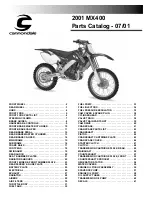
Before mounting the motorcycle, make the following checks:
•
Tires
— Check the air pressure, general wear and tread.
•
Fluids
— Oil and fluid levels. At a minimum, check hydraulic fluids and coolants weekly. Look under the motorcycle for signs of an oil or gas leak.
•
Headlights and Taillight
— Check them both. Test your switch to make sure both high and low beams are working.
•
Turn Signals
—Turn on both right and left turn signals. Make sure all lights are working properly.
•
Brake Light
— Try both brake controls, and make sure each one turns on the brake light.
Once you have mounted the motorcycle, complete the following checks before starting out:
•
Clutch and Throttle
—Make sure they work smoothly. The throttle should snap back when you let go. The clutch should feel tight
and smooth.
•
Mirrors
— Clean and adjust both mirrors before starting. It’s difficult to ride with one hand while you try to adjust a mirror. Adjust
each mirror so you can see the lane behind and as much as possible of the lane next to you. When properly adjusted, a mirror may show
the edge of your arm or shoulder—but it’s the road behind and to the side
that’s most important.
•
Brakes
— Try the front and rear brake levers one at a time. Make sure each
one feels firm and holds the motorcycle when the brake is fully applied.
•
Horn
— Try the horn. Make sure it works.
In addition to the checks you should make before every trip, check the following items
at least once a week: Wheels, cables, fasteners and fluid checks. Follow your owner’s
manual to get recommendations.
KNOW YOUR RESPONSIBILITIES
“Accident” implies an unforeseen event that occurs without anyone’s fault or negligence. Most often in traffic, that is not the case. In fact, most
people involved in a crash can usually claim some responsibility for what takes place.
Consider a situation where someone decides to try to squeeze through an intersection on a yellow light turning red. Your light turns green. You
pull into the intersection without checking for possible latecomers. That is all it takes for the two of you to tangle. It was the driver’s responsibil-
ity to stop. And it was your responsibility to look before pulling out. Neither of you held up your end of the deal. Just because someone else is
the first to start the chain of events leading to a crash, it doesn’t leave any of us free of responsibility.
As a rider you can’t be sure that other operators will see you or yield the right of way. To lessen your chances of a crash occurring:
•
Be visible
— wear proper clothing, use your headlight, ride in the best lane position to see and be seen.
•
Communicate your intentions
— use the proper signals, brake light and lane position.
•
Maintain an adequate space cushion
— following, being followed, lane sharing, passing and being passed.
•
Scan your path
of travel 12 seconds ahead.
•
Identify and separate
multiple hazards.
•
Be prepared to act
— remain alert and know how to carry out proper crash-avoidance skills
.
Blame doesn’t matter when someone is injured in a crash. There is rarely a single cause of any crash. The ability to ride aware, make critical deci-
sions and carry them out separates responsible riders from all the rest. Remember, it is up to you to keep from being the cause of, or an unpre-
pared participant in, any crash.
RIDE WITHIN YOUR ABILITIES
This manual cannot teach you how to control direction, speed or balance. That’s something you can learn only through practice. But control begins
with knowing your abilities and riding within them, along with knowing and obeying the rules of the road.
BASIC VEHICLE CONTROL
BODY POSITION
To control a motorcycle well:
•
Posture
— Sit so you can use your arms to steer the motorcycle rather than to hold yourself up.
•
Seat
— Sit far enough forward so that arms are slightly bent when you hold the handlegrips. Bending your arms permits you to press
on the handlebars without having to stretch.
•
Hands
— Hold the handlegrips firmly to keep your grip over rough surfaces. Start with your right wrist flat. This will help you keep
from accidentally using too much throttle. Also, adjust the handlebars so your hands are even with or below your elbows. This per
mits you to use the proper muscles for precision steering.
•
Knees
— Keep your knees against the gas tank to help you keep your balance as the motor-
cycle turns.
•
Feet
— Keep your feet firmly on the footpegs to maintain balance. Don’t drag your feet. If
your foot catches on something, you could be injured and it could affect your control of the
motorcycle. Keep your feet near the controls so you can get to them fast if needed. Also, don’t
let your toes point downward—they may get caught between the road and the footpegs.
SHIFTING GEARS
There is more to shifting gears than simply getting the motorcycle to pick up speed smoothly. Learning to
use the gears when downshifting, turning or starting on hills is important for safe motorcycle operation.
Shift down through the gears with the clutch as you slow or stop. Remain in first gear while you are
stopped so that you can move out quickly if you need to.
10
2
Test Yourself
More than half of all crashes:
A. Occur at speeds greater than 35 mph.
B. Happen at night.
C. Are caused by worn tires.
D. Involve riders who have ridden their motorcycles
less than six months.
Answer - page 25
HOLDING HANDLEGRIPS
Содержание HSMV 71905
Страница 26: ...26...











































